14. September kl. 22:44. Subtle footprints of algae on the lake bottomDato 14.9.2006
 
I dag skriver forsker Teresa Buchaca (tilknyttet "Center of Avanced Studies of Blanes" i Catalonien og imidlertid ansat ved Danmarks Miljøundersøgelser).
Today we have visited a really beautiful crater lake during our sampling in the Azores, Lagoa Santiago. This lake is situated in a clearly marked crater surrounded by abundant vegetation. We have meet up with Afonso and Roi (our colleagues from the Azores University) and, after packing all the material and tools to use for the sampling in our backs we have started the descent to the lake following a narrow and steep path full of mosses and dense vegetation releasing a pleasant perfume.
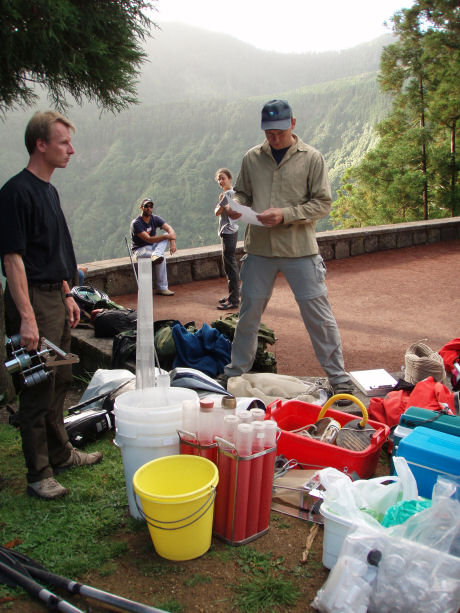
Frank checking that everything was in order.

Karina and Frank during the descent to the lake
Once in the lake, the first task has been to look for the deepest zone. This was in the very middle of the lake, were we measured a depth of 32.5 meters! The lake was relatively transparent and full of fishes that jumped out of the water from time to time. Very interesting place to study food web interactions with very controlled inputs from the small watershed.
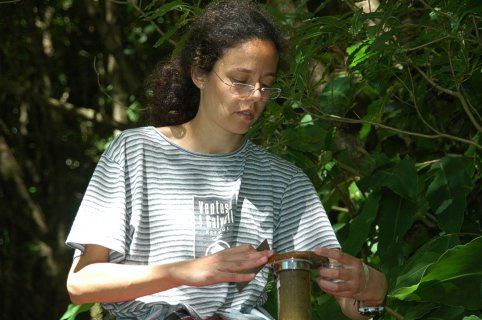
Slicing up the sediment core.
We also have taken several sediment cores, it has been very hard for Sus and Frank to take them out ... but after several trials they got seven good ones! From one of the sediment cores we are going to study among other proxies the pigment composition to infer changes that primary producer assemblages (algae and cyanobacteria) have experienced in the past.
TODAY WE PUT SPECIAL FOCUS ON HOW WE DESCRIBE THE HISTORY OF LAKES BY USE OF ALGAE PIGMENTS RECOVERED FROM THE LAKE BOTTOM.
Marker pigments as palaeolimnological proxies
Broadly defined, palaeolimnology is the study of the physical, chemical, and biological information stored in lake deposits using different indirect indicators, the so-called proxies. Palaeolimnological proxies provide information from which paleoenvironmental changes can be inferred. Some of the most widely used biological proxies in palaeolimnological studies include pollen, diatoms, chrysophyte scales and cysts, plant macrofossils, cladocera, chironomids and organic geochemical proxies. Organic geochemical proxies are contained on the amount and composition of organic matter in lacustrine sediments and include among others, concentration and accumulation rate of organic carbon, Corganic/Ntotal ratio, composition of δ13Corganic and δ15Ntotal and pigments of photosynthetic organisms.
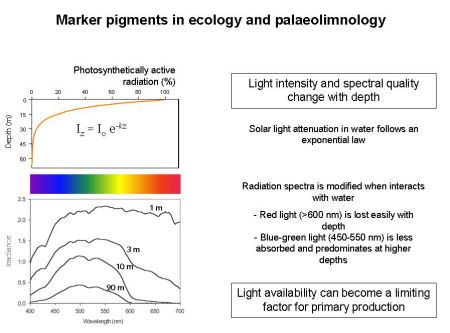
Higher plants, algae and microbes synthesize a variety of pigmented organic compounds for use in photosynthesis. Chlorophyll a is the most common, but aquatic plants have evolved carotenoid compounds that enable photosynthesis in the absence of the red wavelengths absorbed by chlorophyll a. Photosynthetic organisms have a characteristic composition of pigments depending on the Division or Class where they belong which allows the utilization of pigments as taxonomical markers.
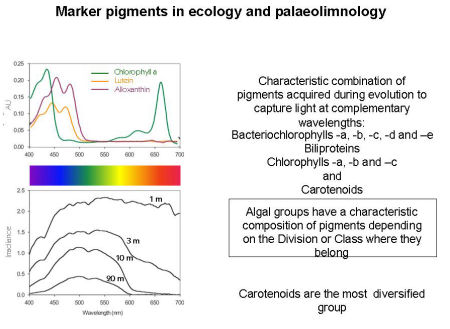
However, the interpretation of the pigment sediment record is not straightforward since pigments are in general very susceptible to degradation. Pigments can reach the sediment in various stages of decay depending on pigment type, the length of time in transit and the degree of chemical and biological attack that has occurred. Among pigments, chlorophylls are in general more labile than carotenoids; however, some of their degradation products (e.g. pheophytins) can be very persistent in the sediment record. As to carotenoids, the stability of the pigment molecule generally depends on its molecular structure and stability declines with the number of functional groups.
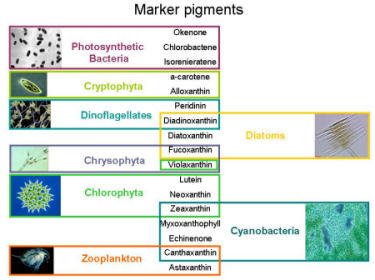
Among pigments carotenoids are the most diversified group and the best suited to found more specific markers. Therefore, when considered together the taxonomical specificity and the differential susceptibility to degradation processes, a subset of reliable marker pigments could be defined to be used in palaeolimnological studies.
Initially, marker pigments were successfully used to reconstruct historical changes in lake primary production and as specific indicators of the presence of cyanobacteria populations. The development of new analytical techniques such as chromatography and a wider knowledge of taxonomic specificity and about diagenetic processes involved made possible to extend its application to the study of changes in lake composition of photosynthetic bacteria, cyanobacteria and algae, to study trophic interactions or to reconstruct the exposition to UV radiation of the system in the past. Marker pigments have also been used as a proxy of anthropogenic perturbations in the aquatic systems, like eutrophication processes, to reconstruct salinity and climate-driven changes or to reconstruct changes in the system stratification and in the depth of the chemocline in meromictic lakes.
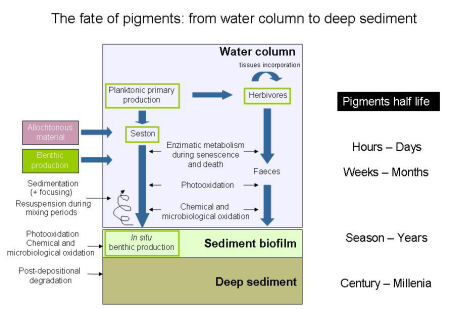
|